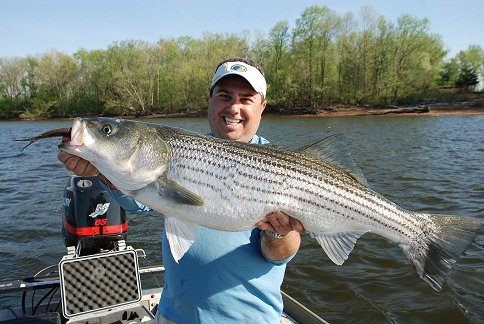NJ Saltwater Fishing Articles
- Details
- Category: Fishing Articles
- Published: Friday, 26 March 2010 20:00
- Hits: 72723
 The Striped Bass fishery along the east coast has rebounded
over the years. Pollution and commercial
fishing once caused a dramatic decrease in the total number of spawning fish
entering the fresh water river systems up and down the eastern seaboard.
Conservation efforts have allowed this fishery to explode.
The Striped Bass fishery along the east coast has rebounded
over the years. Pollution and commercial
fishing once caused a dramatic decrease in the total number of spawning fish
entering the fresh water river systems up and down the eastern seaboard.
Conservation efforts have allowed this fishery to explode.
Our local Delaware River is listed as one of the largest spawning grounds on the east coast. Every spring, cow females must enter fresh water river systems to spawn. Stripers have been known to release eggs as far north as Easton, Pennsylvania. However, much of the spawning process occurs in the tidal sections of Trenton and Philadelphia. Female Stripers will release eggs into the current. As the eggs flow freely downriver, the males finish the process. It is essential for stripers to reproduce in a clean, freshwater environment. Pollution, high water and muddy water can decrease chances for a successful reproduction.

The peak of the Striper run normally occurs during late April and early May. However, good numbers of large fish can be caught earlier as buck shad and herring run the river to spawn. These alternate fish runs provide the Striped Bass with an abundant food source. The Striper's aggressive nature drives them to constantly eat. Plus, they need nutrients, as they will expend energy during the spawning process..................
During the spring Striper run, anglers need to understand that a portion of the river has a closed season. Until June 1, any striper caught below the Trenton Falls must be released. Stripers caught above Trenton Falls may be kept if they are over 28 inches. These laws are subject to change over the winter so please check for any updated information.
Anglers need to be aware that fish in the twenty and thirty pound class are commonly boated. For this very reason, proper equipment is essential. Below, you will find a helpful breakdown of equipment and gear.
Equipment
Stripers are very aggressive and powerful. They are known for making long hard runs that can push fishing gear to their limits. I firmly believe that big fish will find defects in your equipment. Choosing the proper equipment will keep you fishing rather than fixing.
First, start with a Shimano Baitrunner 3500. This reel offers adequate space for 17 pound test line. This becomes critical when fish need to be chased downriver. If you choose a bait-casting reel, look for one with a clicker drag system such as a Tekota 500 or Torium 14. Second, look at either a muskie style rod such as a Compre or a Trevala 7'ML jigging rod by Shimano. Since circle hooks are required by law, the parabolic action of the Trevala allows the rod to load evenly, setting the hook everytime.

Live Bait
Live bait seems to be the most preferred tactic for stripers. Eels can be purchased at local tackle shops. Look for 6-9" eels and hook the eels through the eyes. This will alleviate eels from diving into the rocks. Handling eels can be a pain. I like to chill several eels on ice. Once their metabolism drops, I place them in sand or saw dust. This allows for easy handling. Bloodworms prove to be good baits in March and April as well. Anglers should ball the worms on the hook. Drop the worms to the bottom on a standard top and bottom rig used for flounder fishing. Herring is another choice and can be caught rather easily. Herring fishermen like to anchor along current seams and in the channel. Outfit a bass rod with 1-3 oz weight according to river conditions. Above the weight, attach 3-5 small gold hooks in size 10 or 12. Drop the rig to the bottom and jig until you feel them hit. Simply, reel the herring to the surface and place them in your live well. Be certain to keep fresh water flowing into the live well as Herring die very quickly.
Trolling
Trolling the river for Stripers is rarely seen. Dipsy divers, planer boards and downriggers aid in keeping lures in the strike zone. I will troll lures behind these devices at speeds of 1.8 mph to 3mph. Target flats and narrow channels that provide steep drop-offs. Stripers relate to these forms of structure and are easily trolled. I run the same lures that I cast. Vary your depths and length behind each device till a fish hits. Then you will begin to key in on what they are looking for and at which depth.
Hotspots
Stripers feed heavily on blue back herring as they migrate upriver. This means that Stripers will be close to the Herring. Select fishing spots where schools of herring stack. Eddy currents, flats, drop-offs, bridge pilings and boulders are prime hotspots. However, everyone else knows that as well. Look for alternative spots such as long deep pools, gravel areas, shade during heat waves and whitewater. Lately, Tinicum Island, Raccoon Creek, Rancocas Creek and Trenton have been hotspots for big fish.
Striped Bass will remain in the Delaware all summer. The Easton, Pennsylvania region continually sees large fish in the 40-pound class caught every summer. Boating large stripers during the summer heat can be dangerous to the fish. Extra time is needed to revive these babies. As anglers head north towards the New York border, Striped Bass can be caught. However, numbers of fish and size of fish are reduced.
Try these techniques this spring and I assure you that more Stripers will land in your boat. Keep your bait fresh and always in the strike zone for maximum success. Release the big females for future success and good luck!
Read The Discussion here on Delaware River Stiped Bass Fishing
Capt. Chris Gatley - Ardent Angler Guide Service







